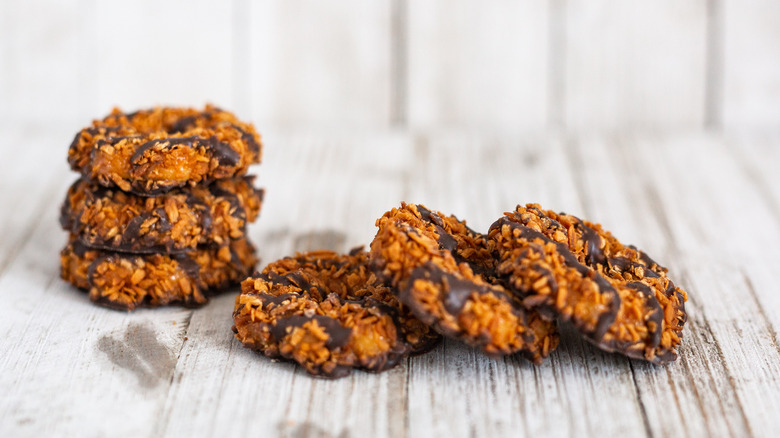Why Girl Scout Cookie Production Was Halted During World War II
For more than 100 years, Girl Scouts across the United States and beyond have been rolling out their annual fund-raising cookie sale. Fans in the know can pretty much set their clocks by the now-iconic event, but that wasn't always the case. During World War II, the Girl Scouts were temporarily forced to suspend the sale of the cookies. It all began in the spring of 1943 when then Girl Scout cookie chairman A.A. Rabe came to the unsettling realization that the organization would not be able to fulfill orders in St. Petersburg, Florida. And one by one, Girl Scout troops across the country realized they were facing the same predicament. Rationing laws enacted during World War II to conserve vital resources had spread to the U.S. food supply, affecting key ingredients — sugar, flour, and butter — necessary to produce the beloved cookies.
It was a blow to the organization, but troops across the country embraced the Girl Scout motto, "Be prepared," and pivoted to a new fund-raising strategy — selling calendars. But that's not all. In some parts of the country, the resourceful young scouts supplemented their fund-raising activities by selling war bonds or collecting and selling scrap metal. The organization's grass-roots efforts kept the Scouts afloat until food supply issues began to ease sometime around 1946 and when the cookies came back, they came back with a bang.
Absence made the heart grow fonder
In the decades leading up to the Second World War, the Girl Scouts' annual cookie drive experienced exponential growth. It began in 1917 when an Oklahoma troop decided to cash in on their burgeoning baking skills, selling the cookies in the local high school cafeteria. In 1922, American Girl magazine published the original recipe — a shortbread-style cookie — encouraging other troops in the nation to jump on the bandwagon. Over the next decade, the annual Girl Scout cookie fundraiser morphed from local bake sale to full-blown business. Councils in Philadelphia and New York led the way, outsourcing production to commercial bakers, and others followed suit. Expansion continued, and profits soared — that is, until the rationing policy in World War II kept a lid on production volume.
The war effort slowed cookie sales for a couple of years, but when rationing eased, sales came back stronger than ever. By 1948, the Girl Scouts had partnered with 29 commercial bakers across the U.S. to produce old and new varieties of cookies. In 1951, a sandwich cookie and a chocolate mint cookie — the precursor to today's best-selling Thin Mints — joined the line-up. The current roster comprises a dozen cookie varieties, all produced by just a pair of commercial bakeries licensed in the U.S. In addition to Thin Mints, longtime standards include Trefoils (inspired by the original shortbread cookie) and Do-Si-Dos (the ever-popular sandwich cookie). In 2018, Fortune reported the annual cookie sale revenue was about $800,000. We have to say it: That's a lot of dough.

